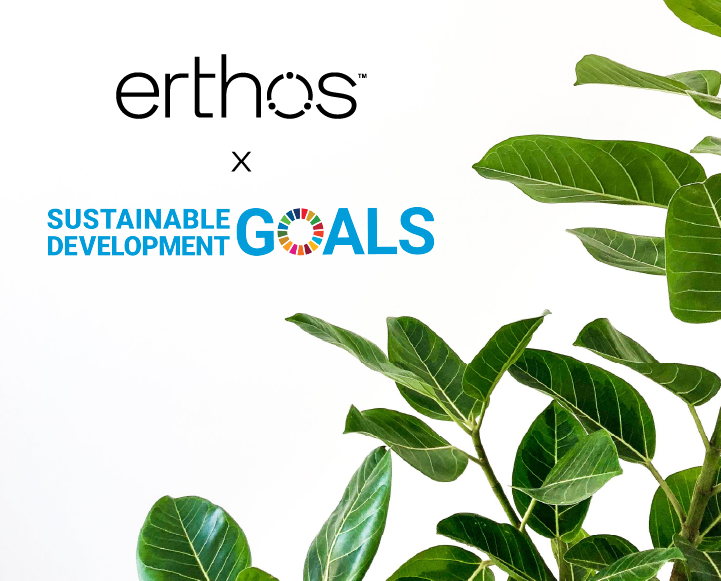Happy COP26 week! As you might already know, the 2021 United Nations Climate Change Conference (COP26) kicked off this week. Every year, world leaders, government representatives, businesses and citizens gather to assess our global progress in tackling climate change.
In the spirit of a week full of powerful climate discussion, we thought it was time to share how erthos™ supports the United Nations (UN) Sustainable Development Goals (SDG’s), also known as the Global Goals. The 17 SDG’s are a universal call to action to achieve an improved balance between social, economic and environmental sustainability.
At erthos, sustainability is our mission. Through our work in creating plant powered alternatives to single-use plastics, we’re taking action everyday to achieve global climate targets and align with 5 important SDG’s:

Here’s how, at erthos, we measure our progress and support our partners in collectively achieving the Global Goals.
2. Zero Hunger
In 2020, nearly one in three people in the world were affected by moderate or severe food insecurity. Unfortunately, in the sustainable materials space, there is a dependence on agricultural feedstocks that are currently in direct competition with a food source. To mitigate this risk; our Product and Supply Chain teams at erthos work hard to guarantee the agricultural byproducts sourced for our materials do not compete with an existing food source. We work closely with our suppliers to understand the impact of each feedstock we source and find the most sustainable material for our customers and partners. We strongly believe that in order to guarantee long-term sustainable impact, we must do our part to align with Goal 2.
12. Responsible Consumption and Production
Materials used to manufacture traditional single-use plastics are an inefficient use of natural resources and have long-lasting impacts on our environment. According to the UN SDG Report in 2021, 5 trillion single-use plastic bags are thrown away each year. Success in fulfilling this goal depends on reducing our ecological footprint by changing the way we produce and consume goods and resources.
Our Compliance Division factors in a sustainable life cycle of our products, with a cradle-to-cradle solution to reduce our ecological footprint for our partners. The impact of our material consumption and production are quantified through detailed energy, water, CO2 and plastic diversion metrics. This data continuously drives our R&D and Manufacturing teams to further optimize and improve our patterns. These key metrics also support many of our partners’ sustainability goals, to transform their systems. Responsible patterns require collective action, and the ability to “rethink” materials like plastics at their core. Learn more about how we’re rethinking single-use plastics and building better patterns for our industry.
13. Climate Action
Now more than ever, the environmental impact of traditional plastics are urging governments at all levels to introduce single-use bans and improve current waste management infrastructure. During this shift, education and awareness is just as important to combat climate change.
We play an active role as a member of councils, committees and certification bodies. As a participating member, we have insight on upcoming and current legislative changes, we provide policy input, and advocate for bio-based plastics as an alternative solution to traditional single-use plastics. Alongside advocating for our industry, we ensure our products and business operations comply with all applicable standards, certifications and compliance obligations. We communicate these key pieces of information to our stakeholders alongside informative and educational posts through our platform. Check out our recent post on composting.
14. Life Below Water
The health of our oceans and seas is deeply connected to the plastic crisis. Every year, an estimated 5 to 12 million metric tonnes of plastic enters the ocean, directly threatening our life below water. At erthos we are working towards mitigating ocean plastics to significantly reduce marine pollution.
We can no longer allow our life below water to suffer from our dependence on single-use plastics. By rethinking the current waste pattern and editing the way we make and use single-use plastics, this is a problem we can solve. Our materials are designed to divert plastics from polluting our environment, and protect our precious marine ecosystems. To learn more about the impact of plastics in our oceans, explore the nonprofit environmental advocacy group, Ocean Conservancy.
17. Partnerships for the Goals
We’ve said it before, and will say it again: partnerships are everything! At erthos, we are committed to working alongside manufacturers, CPG’s, governments and advocacy groups to ensure we are creating a stronger, more sustainable ecosystem. Not only are we building materials to help solve the plastic waste crisis, but we are also trying to solve the challenges that our industry partners and users have been facing when adopting sustainable alternatives. By developing new alternative plastics for their supply chain and providing powerful impact metrics to support their Corporate Social Responsibility targets, we have built an award winning partnership model for our industry.
The UN SDG’s drive our mission at erthos and reinforce our commitment to building better materials for our planet, and for our industry. If you’re interested in strengthening your sustainability goals with our plant powered materials, contact us and let’s put SDG 17 in action!


0 Comments